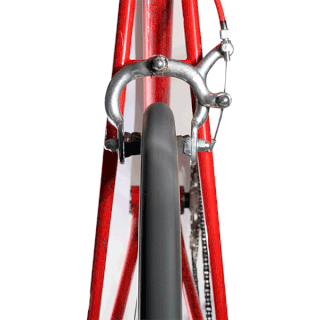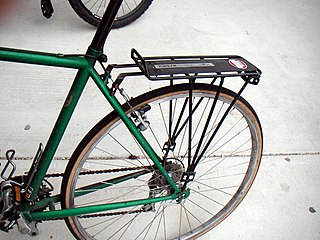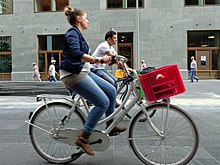
A bicycle, also called a pedal cycle, bike, push-bike or cycle, is a human-powered or motor-powered assisted, pedal-driven, single-track vehicle, having two wheels attached to a frame, one behind the other. A bicycle rider is called a cyclist, or bicyclist.

A tricycle, sometimes abbreviated to trike, is a human-powered three-wheeled vehicle.

A bicycle brake reduces the speed of a bicycle or prevents it from moving. The three main types are: rim brakes, disc brakes, and drum brakes.

A bicycle frame is the main component of a bicycle, onto which wheels and other components are fitted. The modern and most common frame design for an upright bicycle is based on the safety bicycle, and consists of two triangles: a main triangle and a paired rear triangle. This is known as the diamond frame. Frames are required to be strong, stiff and light, which they do by combining different materials and shapes.

A bottle cage is device used to affix a water bottle to a bicycle. Composed of plastic, aluminum, stainless steel, titanium or carbon fiber, it is attached to the main frame of a bicycle, the handlebars, behind the saddle, or, in uncommon cases, the fork. Most modern bicycles have threaded holes in the frame to hold the bottle cage, often called braze-ons even though they may be welded, glued, riveted, or moulded into the frame material. Clamps are necessary on bicycles not so equipped, such as older or less expensive models.

A cargo bike is a human powered vehicle designed and constructed specifically for transporting loads. Cargo bike designs include a cargo area consisting of an open or enclosed box, a flat platform, or a wire basket, usually mounted over one or both wheels, low behind the front wheel, or between parallel wheels at either the front or rear of the vehicle. The frame, drivetrain and wheels must be constructed to handle loads larger than those on an ordinary bicycle.

A touring bicycle is a bicycle designed or modified to handle bicycle touring. To make the bikes sufficiently robust, comfortable and capable of carrying heavy loads, special features may include a long wheelbase, frame materials that favor flexibility over rigidity, heavy duty wheels, and multiple mounting points.

A pannier is a basket, bag, box, or similar container, carried in pairs either slung over the back of a beast of burden, or attached to the sides of a bicycle or motorcycle. The term derives from a Middle English borrowing of the Old French panier, meaning 'bread basket'.

A utility bicycle,city bicycle, urban bicycle, European city bike (ECB), Dutch bike, classic bike or simply city-bike, is a bicycle designed for frequent very short, very slow rides through very flat urban areas. It is a form of utility bicycle commonly seen around the world, built to facilitate everyday short-distance riding in normal clothes in cold-to-mild weather conditions. It is therefore a bicycle designed for very short-range practical transportation, as opposed to those primarily for recreation and competition, such as touring bicycles, racing bicycles, and mountain bicycles. Utility bicycles are the most common form globally, and comprise the vast majority found in the developing world. City bikes may be individually owned or operated as part of a public bike sharing scheme.

A tall bike is an unusually tall bicycle often constructed by hobbyists from spare parts. Typically, two conventional bicycle frames are connected, by welding, brazing, or other means, one atop the other. The drive train is reconfigured to connect to the upper set of pedals, and the controls are moved to the upper handlebar area.

Countersteering is used by single-track vehicle operators, such as cyclists and motorcyclists, to initiate a turn toward a given direction by momentarily steering counter to the desired direction. To negotiate a turn successfully, the combined center of mass of the rider and the single-track vehicle must first be leaned in the direction of the turn, and steering briefly in the opposite direction causes that lean. The rider's action of countersteering is sometimes referred to as "giving a steering command".

Flatland is a freestyle BMX riding style performed on smooth flat surfaces that do not include any ramps, jumps, or grindrails. It is sometimes described as a form of artistic cycling with a blend of breakdancing.

A bicycle trailer is a motorless wheeled frame with a hitch system for transporting cargo by bicycle. It can greatly increase a bike's cargo capacity, allowing point-to-point haulage of objects up to 3 cubic metres in volume that weigh as much as 500 kg. However, very heavily loaded trailers may pose a danger to the cyclist and others, and the voluntary European standard EN 15918 therefore suggests a maximum load of 60 kg on trailers without brakes.

Bicycle and motorcycle dynamics is the science of the motion of bicycles and motorcycles and their components, due to the forces acting on them. Dynamics falls under a branch of physics known as classical mechanics. Bike motions of interest include balancing, steering, braking, accelerating, suspension activation, and vibration. The study of these motions began in the late 19th century and continues today.

Bicycle and motorcycle geometry is the collection of key measurements that define a particular bike configuration. Primary among these are wheelbase, steering axis angle, fork offset, and trail. These parameters have a major influence on how a bike handles.

The Bickerton, also called the Bickerton Portable, was a portable aluminium folding bicycle designed by Harry Bickerton and manufactured in the UK and Australia between 1971 and 1989. Bickerton, an accomplished engineer, suffered a three year driving ban in 1970 following a car crash, and invented the bike for himself, to be carried onto public transport or stored in the trunk of a car as small as an Austin Mini.

A bicycle handlebar is the steering control for bicycles. It is the equivalent of a tiller for vehicles and vessels, as it is most often directly mechanically linked to a pivoting front wheel via a stem which in turn attaches it to the fork. Besides steering, handlebars also often support a portion of the rider's weight, depending on their riding position, and provide a convenient mounting place for brake levers, shift levers, cyclocomputers, bells, etc.

A luggage carrier, also commonly called a (bicycle)rack, is a device attached to a bicycle to which cargo or panniers can be attached. This is popular with utility bicycles and touring bicycles.





















